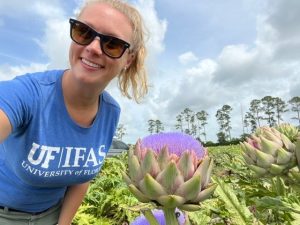Did you know you can plant artichokes in your garden or landscape as well as eat them? That’s because the artichokes you eat are, in fact, immature flower buds.
It’s a timely topic because Florida’s artichoke harvesting season runs from January through May, depending on your location.
“Many home gardeners love artichokes, mostly as edibles,” said Shinsuke Agehara, a University of Florida associate professor of horticultural sciences who harvests the vegetable from January through March at the UF/IFAS Gulf Coast Research and Education Center (GCREC). “But because their flowers are so pretty, I think many will try to keep some late buds to let them bloom in the field.”
That’s what Agehara does at the GCREC near Tampa. Based on his research, he recommends artichoke-growth practices for commercial growers and home gardeners.

Meanwhile, Prissy Fletcher, a commercial vegetable production agent for UF/IFAS Extension St. Johns County, grows artichokes to eat and as cut flowers at the Hastings Agricultural Extension Center.
Producing artichokes in Florida is tricky.
To form buds, they generally require 200 to 1,300 cumulative hours below 50 degrees. But this chilling requirement can be replaced by the use of gibberellic acid. With this plant-growth hormone, it’s possible to produce artichokes without relying on chill hours.
“We have to trick them into thinking they acquired chill because Florida does not provide sufficient hours of cooler temperatures,” Fletcher said.
California grows 99% of the nation’s artichokes, which flourish in a cool Mediterranean environment. But in 2017, UF started trying to grow artichokes at GCREC and at the Hastings center.
That year, Agehara presented initial results at the Florida State Horticultural Society conference. The ‘Imperial Star’ and ‘Green Queen’ showed the most promise of growing in Florida’s warm, humid climate.
With help from gibberellic acid, ‘Imperial Star’ can produce as much as 15,420 pounds per acre, while ‘Green Queen’ can produce 10,485 pounds per acre, Agehara said. By comparison, California producers can grow up to 14,000 pounds per acre.

Over the last seven years, Agehara has been testing additional varieties to identify the most suitable artichoke in Florida’s climate.
In 2023, he selected eight hybrids out of 15 varieties, based on their yield.
This season, he’s performing more detailed yield and quality assessments on those eight hybrids. The preliminary results show that a few of them have potential to outperform ‘Imperial Star’ and ‘Green Queen.’
Although there are not official records showing how many acres of artichokes are grown in Florida, UF/IFAS experts are also continually trying to get farmers to produce the vegetable.
Fletcher has gone to a farmer’s market in St. Augustine for a little consumer research. Based on which artichoke looked the best, shoppers voted ‘Green Queen’ as their favorite artichoke.
She and other Extension agents are working on getting more farmers in North Florida to grow artichokes, adding that “local chefs love them. We just need a local source.”
###
Para accesar a esta comunicación en español, por favor utilice este enlace.
ABOUT UF/IFAS
The mission of the University of Florida Institute of Food and Agricultural Sciences (UF/IFAS) is to develop knowledge relevant to agricultural, human and natural resources and to make that knowledge available to sustain and enhance the quality of human life. With more than a dozen research facilities, 67 county Extension offices, and award-winning students and faculty in the UF College of Agricultural and Life Sciences, UF/IFAS brings science-based solutions to the state’s agricultural and natural resources industries, and all Florida residents.
 4
4
